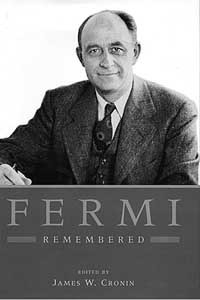Nobel laureate Cronin edits book on Fermi’s legacy
By Steve KoppesNews Office
 | |
Physicists speak of Fermi acceleration and Fermi liquid, Fermi pressure and Fermi gas, the Fermi paradox and Fermi questions, the Fermi-Thomas model of the atom and the Fermi-Turkevich gap.
Fermi also has left his name on the element fermium, a class of subatomic particles called fermions, Enrico Fermi High School in Enfield, Conn., Fermi National Accelerator in Batavia, Ill., and the Enrico Fermi Institute at the University.
So who was Enrico Fermi? A new book edited by James Cronin, University Professor Emeritus in Physics and the College, attempts to answer that question.
The book, titled Fermi Remembered, describes the many-faceted scientific legacy of the Nobel laureate, whose contributions to 20th-century physics are perhaps unmatched for their broad scope.
The University Press published the book with contributions from seven Nobel Prize winners and many other scientists who studied under or worked with Fermi at Chicago from 1946 until his death in 1954.
Albert Einstein’s relativity theory and the quantum mechanics developed by Werner Heisenberg and Erwin Schrdinger are often cited as milestones in 20th-century physics. But for sheer breadth of achievement, Fermi left a unique signature on modern physics.
“He gave to science all he had, and with him disappeared the last universal physicist in the tradition of the great men of the 19th century, when it was still possible for a single person to reach the highest summits, both in theory and experiment, and to dominate all fields of physics,” wrote the late Nobel laureate Emilio Segr of Fermi in 1962.
Although not a biography, the book contains reminiscences of Fermi from 25 scientists who knew him, as well as material from his research notebooks, correspondence, speech outlines and teaching.
Among Fermi’s early accomplishments was to apply quantum mechanics, which explains the behavior of atoms and subatomic particles, to the physics of solids and gases, Cronin said. In the 1920s, he built on quantum theory by formulating concepts called Fermi energy and, with Paul Dirac, Fermi-Dirac statistics. These concepts later became vital to the development of semiconductors and other electronic devices.
Fermi went on to earn the Nobel Prize in 1938 for his discovery of new radioactive elements produced by the addition of neutrons to the cores of other atoms, and for the discovery of nuclear reactions brought about by slowly moving neutrons. He also directed construction of the first nuclear reactor at the University during World War II as part of the effort to develop the atomic bomb. But he turned his attention to an entirely new topic after the war.
While researching the book, Cronin discovered a 1945 letter from Fermi outlining his vision for the newly formed research institute that now bears his name at the University. “That was to do high-energy physics, not nuclear physics, not following up what he had done with the bomb,” Cronin said. “He was looking far, far ahead of that.”
Fermi’s papers also reveal a man of humanity as well as science, Cronin said. In 1945, Fermi wrote a letter to U.S. Secretary of State James Byrnes expressing his concern over the fate and repatriation of Italian Jews deported to Germany during the war. In 1952, he co-signed another letter to Secretary of State Dean Acheson vouching for the integrity of chemist Linus Pauling, who had been denied a passport for travel to England. Many other letters show his continuing worries about the control of nuclear weapons.
The reminiscences convey a sense of Fermi’s personality. For example, Harold Agnew, who witnessed the initiation of the first controlled nuclear chain reaction in 1942, told the story of Fermi’s wife attempting to buy a General Electric dishwasher. This was after the war—appliances were scarce—and there was a waiting list of several months. Agnew suggested that Fermi take advantage of his professional relationship with the president of GE to get a dishwater immediately. But Fermi declined, saying that wouldn’t be fair. “This was classic Fermi,” Agnew wrote.
In the book’s last chapter, Cronin analyzes a forward-looking talk Fermi gave in January 1954 as the retiring president of the American Physical Society. Fermi’s outlines and slides for the talk survive today in the Special Collections Research Center of the University Library.
In his talk Fermi undertook a difficult task—to predict how the power of particle accelerators would grow over the next 40 years.
His chart began with the first low-powered accelerator in 1930, and topped out in 1994 with what Cronin dubbed “the Globatron,” an accelerator that girdled the Earth at the equator. Fermi was wrong about the size and cost of the Globatron, but its projected energy already has been achieved through technological advances.
Unfortunately, stomach cancer cut Fermi’s career short in 1954, just as the growing power of particle accelerators ushered in a golden age of discovery.
Cronin thus ends his book wistfully: “One wonders what his contributions might have been.”
![[Chronicle]](/images/sidebar_header_oct06.gif)